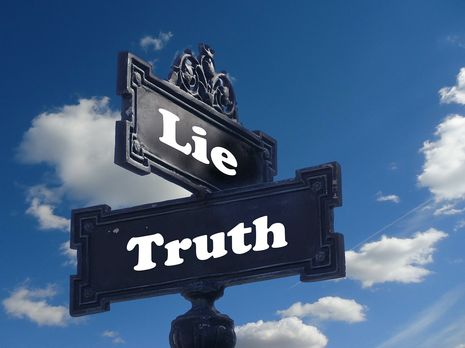How to read a lie
Vianca Shah sheds light on the subtle expressions and physiological changes that can reveal dishonesty, and discusses whether it is possible to reliably detect lies.

The research of Paul Ekman in 1971 seemed to be clear – facial expressions are universal. Dr. Ekman set off to Papua New Guinea to investigate this theory, to interact with a tribal community isolated from outside interaction.
The universal 'facial expressions' are disgust, anger, fear, sadness, happiness or surprise. However, this viewpoint is somewhat oversimplistic. In reality, there are two subgroups to consider. Macroexpressions are expressions lasting greater than 200ms in duration, whereas microexpressions are much shorter. Different microexpressions can be then integrated into a larger macroexpression, and the presentation of this, as Ekman discovered, was universal.
Microexpressions have similar features to macroexpressions in terms of basic appearance, but EEG (electroencephalogram) and ERP (event related potential) results show the neural activities of the two are significantly different. The left hemisphere of the brain is more important than the right in a microexpression, and there are differences in individual areas of the brain, including the frontal lobe and the inferior temporal gyrus. The purpose of microexpressions is not entirely clear, but it is suspected that they may be key behavioural clues to detect danger and deception. Therefore, if we learnt how to read these expressions, could we learn how to identify a liar?
Out of the universal facial expressions, fear is the most obvious emotion expected when lying. However, lying can also produce positive expressions via a phenomenon known as 'duping delight' – when an individual draws pleasure from their ability to deceive successfully. Sometimes it can be a mix of these emotions or, if the stakes are low, no significant expression at all. With all the possibilities, no expression can be completely indicative of a lie. It seems difficult to distinguish all these emotions, ‘universal’ or not.
Facial expressions can, however, indicate that a situation is more complicated than may initially meet the eye. Whilst they might not provide certainty, the combination of certain uncontrollable microexpressions with an intent to deceive can at least suggest that an individual's motives may be questionable. In a study where 78 participants were asked to simulate a parent’s plea for their missing child, none of the participants could convey the same extent of sadness and grief as a genuine plea. Some even displayed expressions of happiness. Specific muscles may be responsible for certain expressions, and so their lack of activity can give away deception. A study by Brinke and Porter in 2012, for example, showed that ‘grief muscles’ contracted in those telling the truth, whilst other muscles (zygomatic major and frontalis) contracted in the faces of liars in order to hide smiles or show sadness. However, as before, some expressions could be neutralised, exaggerated or replaced, perhaps intentionally.
Even if one could control their facial expressions on the ‘outside,’ surely they can't control the ‘inside’? It was this notion that led to the invention of the polygraph, which has since been coined a so-called ‘lie detector’. Instead of using facial expressions, the machine records features such as blood pressure, pulse, respiration and skin conductivity in an attempt to measure truthfulness. Widely used in law enforcement – including for the interrogation of suspects – it has been cited as reaching an accuracy between 81% to 91%. Such tests are treated by psychologists with some scepticism, however, as a physiological response does not necessarily correlate with deception, and may instead relate to fear – a ‘white coat’ effect of sorts.
“Specific muscles may be responsible for certain expressions, and so absence of their activity can give away deception.”
As with many fields, the role of technology in the detection of lies is becoming ever prominent. Machine learning is working to contribute towards detecting facial expressions associated with deception. Features such as pupil dilation, the time taken to respond, the duration of response and the rapid movement of the eye have been shown by machine learning models to be different (both in the presence of a human and humanoid robot) between true and false answers. While such methodology would be dependent on external factors such as light conditions, analysing minute differences in facial expressions can be promising in a wide variety of sectors. One study achieved a 71% accuracy in one instance with a robot, which, if combined with human experience or associated human technique and analysis of facial muscle movements (Facial Action Coding System), could show significant promise.
The idea of reading and understanding facial expressions could revolutionise our interactions and functioning as a society. For example, the ability to detect the truth would arguably be useful in the field of law. However, there are significant ethical concerns associated – is it correct to interpret emotions someone might be trying to keep private? On the other hand, perhaps increased understanding of what our microexpressions mean could help individuals to gain a clearer understanding of emotions that they may be struggling to rationalise or justify. There is much to be learnt around facial expressions and microexpressions, but we always should be cautious before branding anyone a liar.
 News / CUP announces funding scheme for under-represented academics19 December 2025
News / CUP announces funding scheme for under-represented academics19 December 2025 News / SU reluctantly registers controversial women’s soc18 December 2025
News / SU reluctantly registers controversial women’s soc18 December 2025 News / Cambridge welcomes UK rejoining the Erasmus scheme20 December 2025
News / Cambridge welcomes UK rejoining the Erasmus scheme20 December 2025 Features / Should I stay or should I go? Cambridge students and alumni reflect on how their memories stay with them15 December 2025
Features / Should I stay or should I go? Cambridge students and alumni reflect on how their memories stay with them15 December 2025 Film & TV / Timothée Chalamet and the era-fication of film marketing21 December 2025
Film & TV / Timothée Chalamet and the era-fication of film marketing21 December 2025










